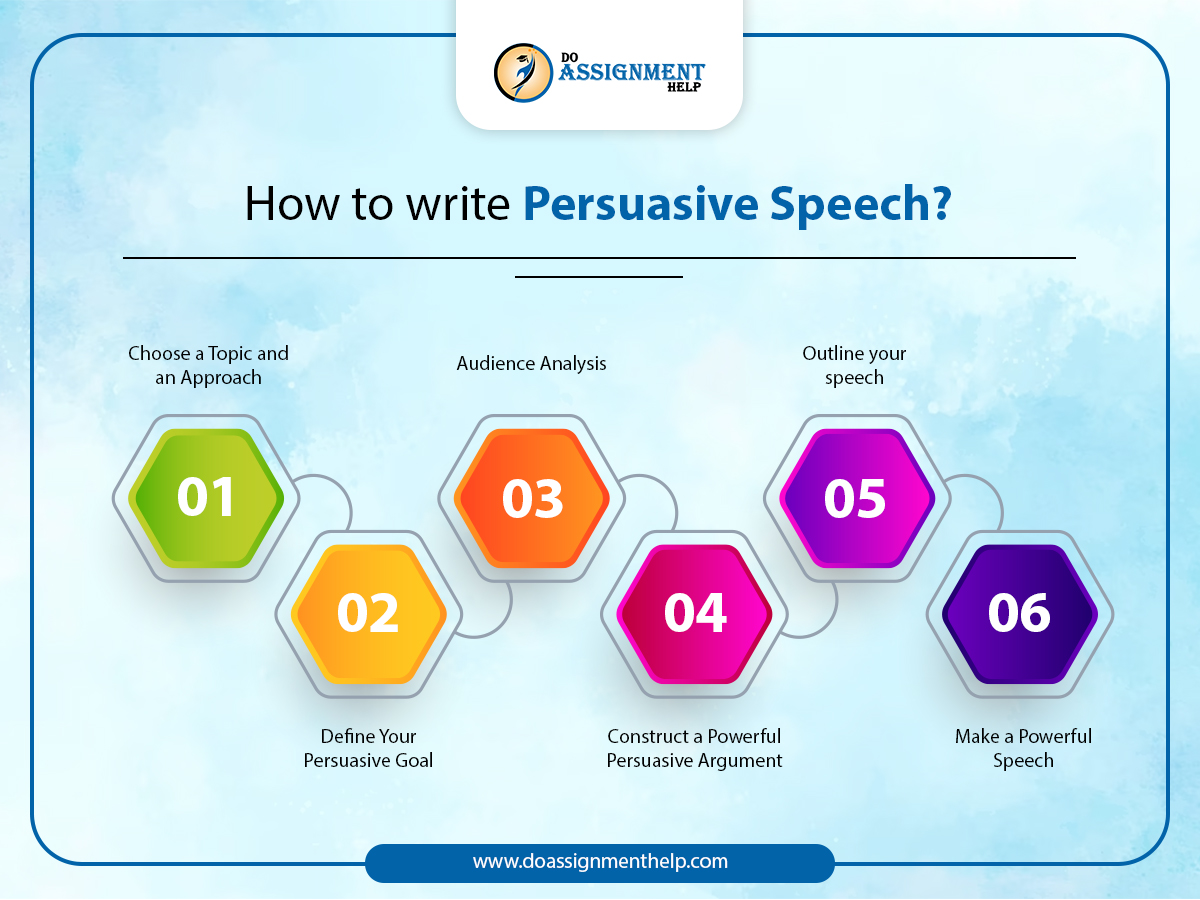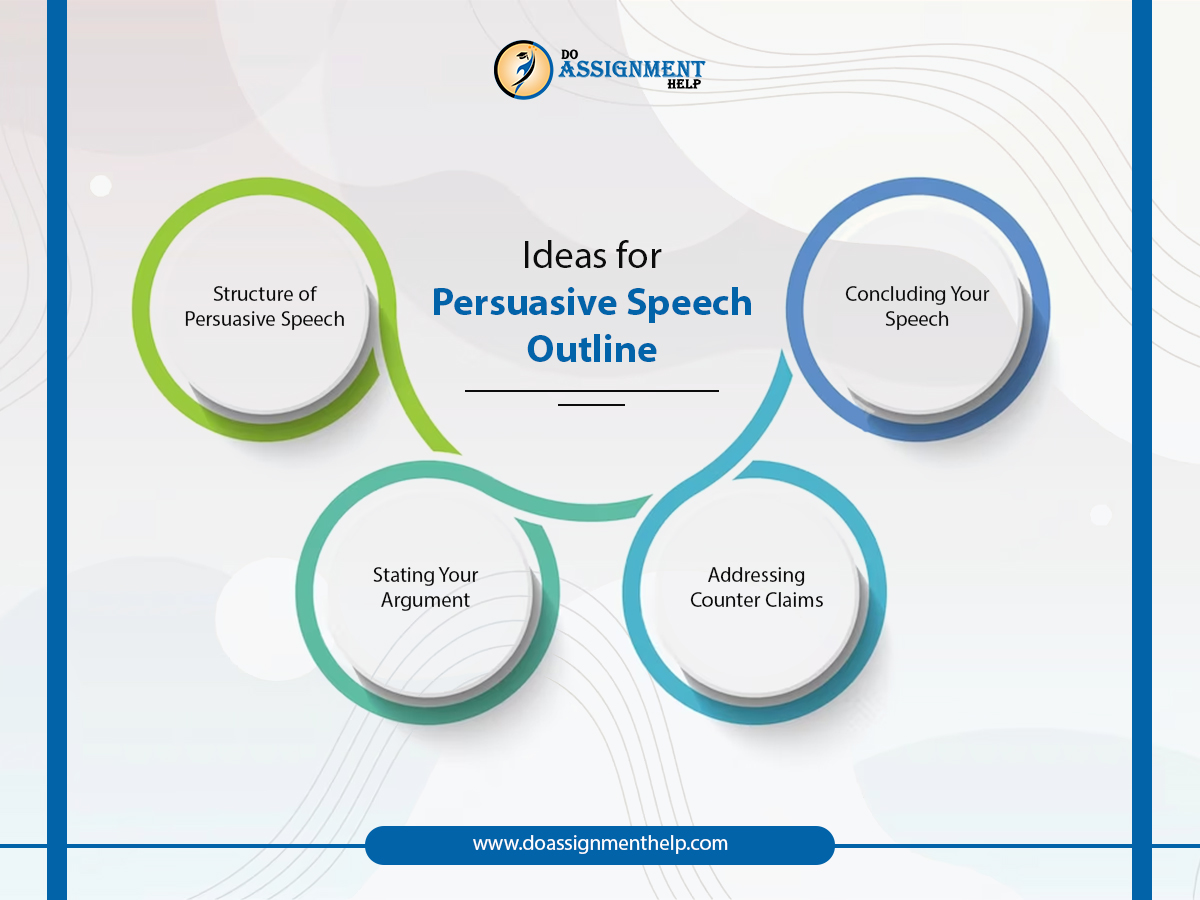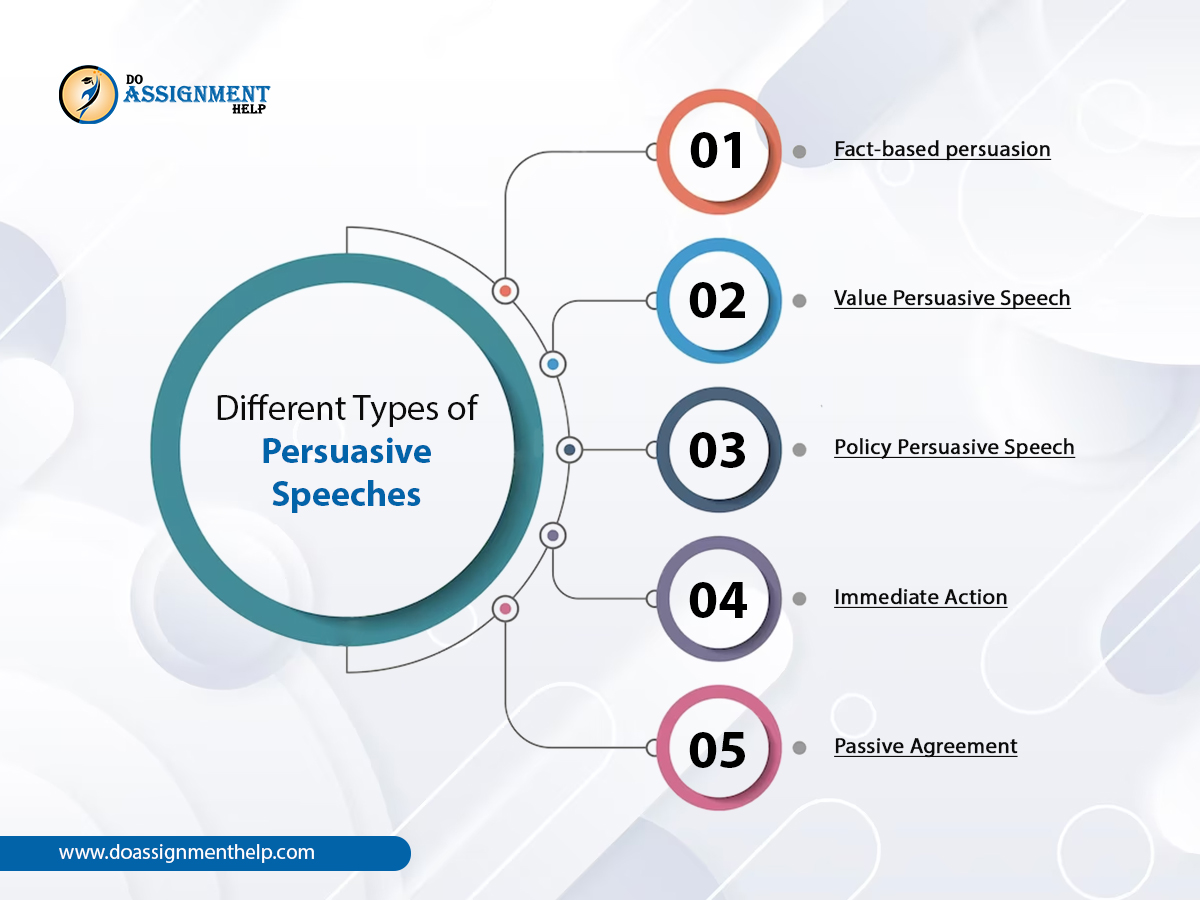Writing and delivering an effective persuasive speech is a skill that will benefit you not just in college but also in your profession and personal life. Delivering a convincing speech will only help you to succeed, regardless of whether you’re presenting a graded speech, or explaining. In this blog, we are going to share how to write a persuasive speech along with types and outlines.
So, Let’s explore and learn more about persuasive speech.
Table of Contents
What is a Persuasive Speech?
The purpose of a persuasive speech is to persuade or convince the audience to agree with the speaker’s viewpoint or take the expected action. To influence the audience’s thoughts and actions, the speaker uses both verbal and visual cues. While Writing a persuasive speech, there are three different styles of rhetoric that are used:
Ethos: Ethos is the credibility of the speaker. An effective speaker persuades the audience that they are informed about the topic and worthy of their attention.
Pathos: The speaker’s capacity to elicit strong feelings from the audience is known as pathos. By appealing to feelings like sympathy or horror, the speaker engages and convinces their listeners.
Logos: The ability of a speaker to convince a listener by using logic and reason is referred to as logos. They use examples and accompanying evidence to make their point and persuade the listener that it is true.
In addition to using words, a speaker can also, tone, body language, confidence, and the setting to sway an audience.
How to Write Persuasive Speech?
If you choose your topic carefully and adequately prepare, writing a compelling speech need not be challenging. If you’re prepared to learn how to write a persuasive speech outline, start by following these essential steps.

Step 1: Choose a Topic and an Approach
Create a contentious topic that, regardless of your stance, will spark lively discussions. Anything from abortion to human trafficking or even animal rights could fall under this category. If you have the option to pick your topic, pick something you are enthusiastic about.
Make sure your topic isn’t too wide by deciding on a specific perspective to concentrate on. Thoroughly research the subject, concentrating on the background, important details, and arguments for and against your perspective.
Step 2: Define Your Persuasive Goal
After settling on a subject, the following stage is to determine precisely how you intend to persuade your audience.
- Are you attempting to convince people toward a particular viewpoint on a subject?
- Are you expecting that after hearing you speak, they’ll alter their conduct or opinion?
- Do you want them to decide whether to buy something or give money to a good cause?
Making informed choices about how to write a persuasive speech and deliver your speech will be made easier for you if you are aware of your objectives. Look through persuasive writing examples to observe various objectives in action.
Step 3: Audience Analysis
Every time you write a speech, it is crucial to comprehend your audience’s point of view. This is especially true while giving a persuasive speech because you’re not only trying to convince people to listen to you; you also want them to act in a certain way after hearing what you have to say.
Think about the audience’s age, sex, and other demographic details, as well as their motivations for attending.
In order to better relate to your audience, take into account how they would likely view the issue you are speaking about.
Recognize the challenges that the audience faces or experiences in relation to the subject so that you may develop relevant persuasive arguments to overcome the challenges.
Step 4: Construct a Powerful Persuasive Argument
You’ll be prepared to create a powerful compelling argument to present in the form of a speech if you have a clear aim, are informed about the subject, and have insights into your audience. Adhere to the recommended procedures for creating a memorable speech.
Persuasive Strategies
Decide which persuasive strategies are most likely to assist you achieve your goal before you do anything else.
- Would a persuasive emotional argument assist attendees accept your point of view?
- Should you pose a rhetorical question to your audience to encourage thought?
- Is it possible to convince an audience using arguments and reasoning effectively?
- Is there a chance that a bandwagon appeal could be successful?
Step 5: Outline your speech
Your next step to understanding how to write a persuasive speech is a keyword outline to collect your important points and plan your persuasive speech for maximum impact once you have determined which persuasive methods are most likely to be successful.
Start off strong by introducing your topic, explaining why it’s important, and outlining the action you want your audience to do as a result of your presentation.
List your main arguments and make sure you fully address each one. Also, make sure you develop the case for your stance and disprove any competing viewpoints.
Ask audience members to act in a way that shows they have been persuaded by you as you draw to a close.
The methods for creating a motivating speech can be quite helpful as you organize your speech because motivation plays a significant role in persuading.
Step 6: Make a Powerful Speech
Of course, what you say matters, but so does how you say it. This includes the graphic tools you use and your general presenting style.
To captivate and persuade your audience, use the right visuals to provide to them, such as charts, graphs, pictures, or illustrations.
You should practice until you can confidently deliver your speech. Maintain eye contact, project your voice, and refrain from using ums, uhs, or other vocal stutters.
Allow your excitement for your subject to come through; it just might be what it takes to persuade the audience to agree with you.
Ideas for Persuasive Speech Outline
Here we are going to share some simple ideas for creating a proper structure along with some persuasive speech outline templates and persuasive speech outline examples:

1. Structure of Persuasive Speech
The most crucial parts of a speech are the introduction and conclusion. When preparing the outline for your persuasive speech, carefully consider these. A compelling opener guarantees that you have the audience’s attention right away and creates a favorable first impression.
You should begin with a powerful beginning, such as an attention-grabbing fact, statistic, or statement. These are frequently dramatic or startling, persuasive speech outline example are:
Sadly, four Americans who are still alive will perish from the food they eat in the next 18 minutes when I conduct our conversation – Jamie Oliver
Include your audience in the picture that you’re trying to build as a persuasive speech opener. You establish an emotional connection between them and your speech by including them in the narrative.
By speaking about a topic you are aware of as being shared by you and your audience, you could approach this in a milder manner. Adding your qualifications to a persuasive speech at this point might also assist you win over your audience’s trust.
2. Stating Your Argument
To give yourself enough time to clarify your position and persuade your audience to share it, you should choose between two and four subjects to cover in your speech.
Each of your points must flow naturally into the following one in order for your speech to make sense. Improve your transitional language between each of your themes to make your speech easier to follow.
Instead of relying solely on your personal perspective, your case should be supported with objective research. Make your issue more relatable to the audience by using examples, analogies, and stories. This will increase the likelihood that they will accept your point of view.
3. Addressing CounterClaims
Any rational idea or school of thinking responds to and refutes any objections raised. By answering these, you’ll improve your persuasive speech by dispelling your audience’s concerns and demonstrating that you are aware of alternative viewpoints on the subject.
Don’t use biased language to describe an opposing viewpoint; instead, describe it as someone who shares that viewpoint would. By doing so, you’ll avoid upsetting audience members who disagree with you and demonstrate how you arrived at your viewpoint after using sound judgment. Just mention any counterarguments and offer justifications for them.
4. Concluding Your Speech
Your speech’s final sentence is your last opportunity to persuade the audience of what you have to say. Make sure it’s a strong one because it’s also the one they’ll remember the most from your entire speech.
The best persuasive presentations conclude with a request for action. If you’ve been discussing organ donation, for instance, your call to action might be to encourage the audience to sign up as donors.
If someone in the audience asks you a question, make sure you respectfully and thoroughly hear their entire question. Don’t get defensive or interject in the middle of a question.
If you disagree with their point of view, you should demonstrate that you did so by providing an objective argument against it. Be sure to always be kind, patient, and courteous.
Different Types of Persuasive Speeches
Now you know how to write a persuasive speech you should know Persuasive speech types. However, what kind of persuasive speech it is depends on the topic and content of the speech. The following three categories of persuasive speeches are used to influence audiences:

1. Fact-based persuasion
A factual persuasive speech is the first category of persuasive speech. It is based on whether a certain assumption or claim is accurate or untrue and is supported by substantial evidence. It makes an effort to convince the audience that something happened or that something doesn’t exist.
Some factual assertions are straightforward to refute and manage. As an illustration, a speaker mentions Neil Armstrong’s 1969 moon landing. The fact that Neil Armstrong actually did land on the moon is supported by this example, which is well-documented and provides hard data.
On the other hand, certain facts are difficult to prove and cannot be definitively answered. For instance, the ideal age for marriage or the drawbacks of medical testing. There isn’t enough information to definitively refute these factual assertions in any one particular way.
Predictions of what might or might not happen are another set of factual assertions that are challenging to explicitly refute. The speaker can try to persuade the audience that the Covid-19 virus will persist till 2021, for instance. You may have evidence that it will cease at the start of 2021, but you are still unsure of the exact details.
As a speaker, it is your responsibility to persuade your audience, who serves as both the opposition’s lawyers and the jury.
2. Value Persuasive Speech
A value persuasive speech determines if something is good or awful, right or wrong, beautiful or ugly, moral or immoral, etc. It examines the moral and ethical implications of a certain subject or establishes the veracity or untruth of a claim.
Can you, for instance, demonstrate the morality or immorality of the death penalty? For example, the government has increased the levy on gas-guzzling monsters. These are a few instances of a value persuasive speech when it is impossible to establish if something is moral or immoral, good or bad.
Your point of view may be shared by the opposing speaker or the audience. When listening to a value and needing more assistance persuasive speech assistance with assignment help, it might be challenging to understand the speaker’s reasoning behind taking a particular stand on a given subject without also paying attention to his evaluation criteria.
For instance, if a compelling speaker claims that social networking sites, in general, are immoral, it should come as no surprise that he also thinks online dating is immoral. As a result, the speaker must clearly clarify his standards for making a certain evaluation remark. In the end, the speaker must give a clear standard and label for how he arrived at that judgment.
3. Policy Persuasive speech
Policy assertions are the second most typical claim in persuasive communication. This assertion is made to persuade the audience to support or oppose a particular candidate, policy, or rule. It makes arguments about the nature of the issue and the best course of action. Given that our society is governed by laws, rules, and policies, it is arguably the most typical sort of persuasive discourse.
For example, a speaker can argue that the legal definition of prostitution has to be updated in order to garner support and prompt action. A prompt call to action is encouraged by this kind of claim. It always expresses an unambiguous opinion about what needs to change and what needs to happen.
The following two persuasive goals are discussed in the policy claim: urgent action and passive agreement.
4. Immediate Action
The audience is persuaded to begin acting in a particular way by immediate action. The speaker must swiftly persuade the audience to follow his suggestion.
In a lecture given to students in a school, for instance, the speaker would try to encourage them to eat more fruits. I’m urging you to eat the apple I gave you and include other fruits in your diet because he would say that eating an apple a day keeps the doctor away.
The speaker’s action prompts the audience to adopt his suggestion right away. Keep in mind that the quicker you get your audience to accept your suggestion, the more probable it is that they will do so.
5. Passive Agreement
A passive agreement, which merely needs the listener to concur with what the speaker is saying, is an alternative to instantaneous action. When a speaker seeks to elicit a passive response from the audience, he or she wants them to accept the speaker’s position or the policy without actually acting on it.
The primary objective of the passive agreement is to persuade the audience to adopt a particular attitude, value, belief, or conduct, as opposed to forcing the audience to engage in any particular behavior.
Final Thought
A persuasive speech is a powerful weapon that speakers can use to connect with their audience on an emotional and intellectual level in order to shape their beliefs and behavior. Speakers who are aware of the ethos, pathos, and logos concepts are better able to establish credibility, elicit strong feelings, and make compelling arguments.
Thorough research, audience analysis, and the creation of an outline that tackles objections and presents convincing evidence are required when creating a persuasive speech. While understanding how to write a persuasive speech you should know nonverbal cues and a confident delivery are also part of the art of persuasive speaking, which increases the impact of the message. As speakers develop their persuasion skills, they can persuasively argue for causes, bring about change, and motivate their audience to take action.
 Santa Clara, CA 95050
Santa Clara, CA 95050 





